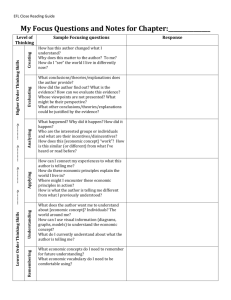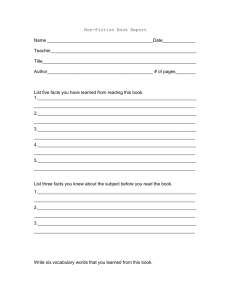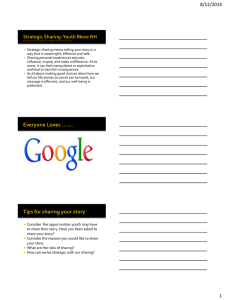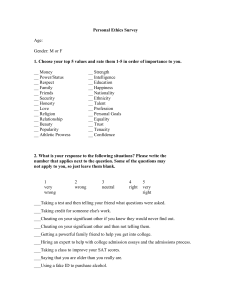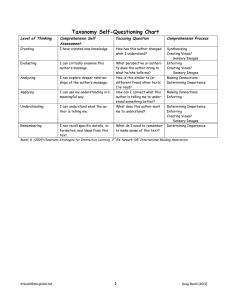Reading Like an Insider Self-Questioning Taxonomy Level of Comprehension
advertisement
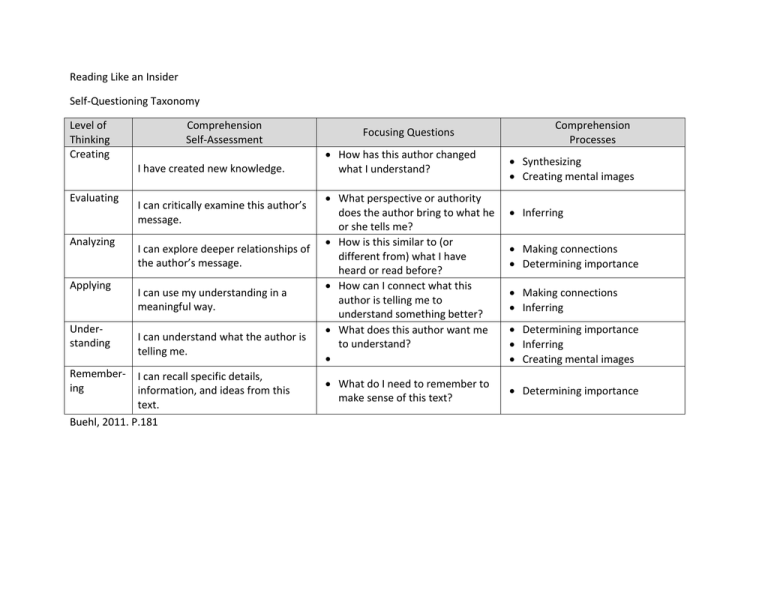
Reading Like an Insider Self-Questioning Taxonomy Level of Thinking Creating Comprehension Self-Assessment I have created new knowledge. Evaluating Analyzing Applying Understanding Remembering I can critically examine this author’s message. I can explore deeper relationships of the author’s message. I can use my understanding in a meaningful way. I can understand what the author is telling me. I can recall specific details, information, and ideas from this text. Buehl, 2011. P.181 Focusing Questions How has this author changed what I understand? What perspective or authority does the author bring to what he or she tells me? How is this similar to (or different from) what I have heard or read before? How can I connect what this author is telling me to understand something better? What does this author want me to understand? What do I need to remember to make sense of this text? Comprehension Processes Synthesizing Creating mental images Inferring Making connections Determining importance Making connections Inferring Determining importance Inferring Creating mental images Determining importance Reading Like an Insider Self-Questioning Taxonomy for History Texts Level of Thinking Creating Evaluating Comprehension Self-Assessment I have created new knowledge about the pas I can critically examine this author’s conclusions/ interpretations/ explanations Analyzing I can understand why Applying I can use my understanding to better understand how the past influences my life and world. I can understand what the author is telling me about the past. Understanding Remembering I can recall specific details, information, and ideas from this text. Buehl, D. (202011), p.19009). Focusing Questions How has this author changed what I understand? Why does this matter to the author? To me? Who is the author and how has author perspective influenced the telling of this history? What conclusions/interpretations/explanations does the author provide? How did the author find out? What is the evidence? How can we evaluate this evidence? What other conclusions/interpretations/explanations could be justified by the evidence? Does the author have an attitude, and if so, about what? Whose viewpoints are not presented? What might be their perspective? What happened? What caused it to happen? What changed and what remained the same? Who benefited from the changes? Who didn’t? How des the author talk about the effect of past decisions or actions on future choices? How can I connect my experiences and knowledge to what this author is telling me? How does studying the past help me understand my life and my world? What does this author want me to understand about the past? What questions does the author ask of the past? How did people in this time period view their lives and world? What do I need to remember to make sense of the past? Reading Like an Insider Self-Questioning Taxonomy for Biology Texts Level of Thinking Creating Evaluating Comprehension Self-Assessment I have created new knowledge about the biological world. I can critically examine this author’s conclusions/ theories/explanations. Analyzing I can understand why Applying I can use my understanding to better understand the biological world. Understanding I can understand what the author is telling me about the biological world. Remembering I can recall specific details, information, and ideas from this text. Buehl, D. (202011), p.199). Focusing Questions How has this author changed what I understand? How has this author corrected my previous misunderstandings? What conclusions/theories/explanations does the author provide? How did we know? What is the evidence? What other conclusions/eheories/explanations could be justified by the evidence? What happened? Why did it happen? How did it happen? How does this [biological concept] work? Why does this this [biological concept] work the way it does? What are its defining characteristics? How is this similar to (or different from) other related biological concepts? How can I connect my experiences and knowledge to what this author is telling me? How can I use what this author is telling me to better understand living things? How is what the author is telling me different from what I previously understood? What does this author want me to understand about living things? How does the visual information help me understand what the author tells me? What do I currently understand about what the author is telling me? What biological concepts do I need to remember for future understandings? What biological vocabulary do I need to become comfortable using? Reading Like an Insider Self-Questioning Taxonomy for Physical Science Texts Level of Thinking Creating Comprehension Self-Assessment I have created new knowledge about the physical world. Evaluating I can critically examine this author’s conclusions/ theories/explanations . Analyzing I can understand why Applying I can use my understanding to better understand the physical world. Understanding I can understand what the author is telling me about the physical world. Remembering I can recall specific details, information, and ideas from this text. Buehl, D. (202011), p.200). Focusing Questions How has this author changed what I understand? How has this author corrected my previous misunderstandings? How do I see the world I live in differently now? What conclusions/theories/explanations does the author provide? How did we know? What is the evidence? What do our observations tell us? Are our observations consistent with the scientific principles we are examining? What are possible limitations of our investigations? What other conclusions/theories/explanations could be justified by the evidence? What happened (or happens)? Why does it happen? How does it happen? What process do objects go through? What happens at each stage of the process? What are the relationships that cause each effect in this process? How can we model this process? How can these scientific principles be demonstrated? How can I connect my experiences and knowledge to what this author is telling me? How do these scientific principles Where might I encounter these scientific principles in action? How is what the author is telling me different from what I previously understood? What does this author want me to understand about the physical world? What do I currently understand about what the author is telling me? Can I use my imagination to see what the author wants me to understand? What scientific principles do I need to remember for future understandings? What science vocabulary do I need to become comfortable using?
